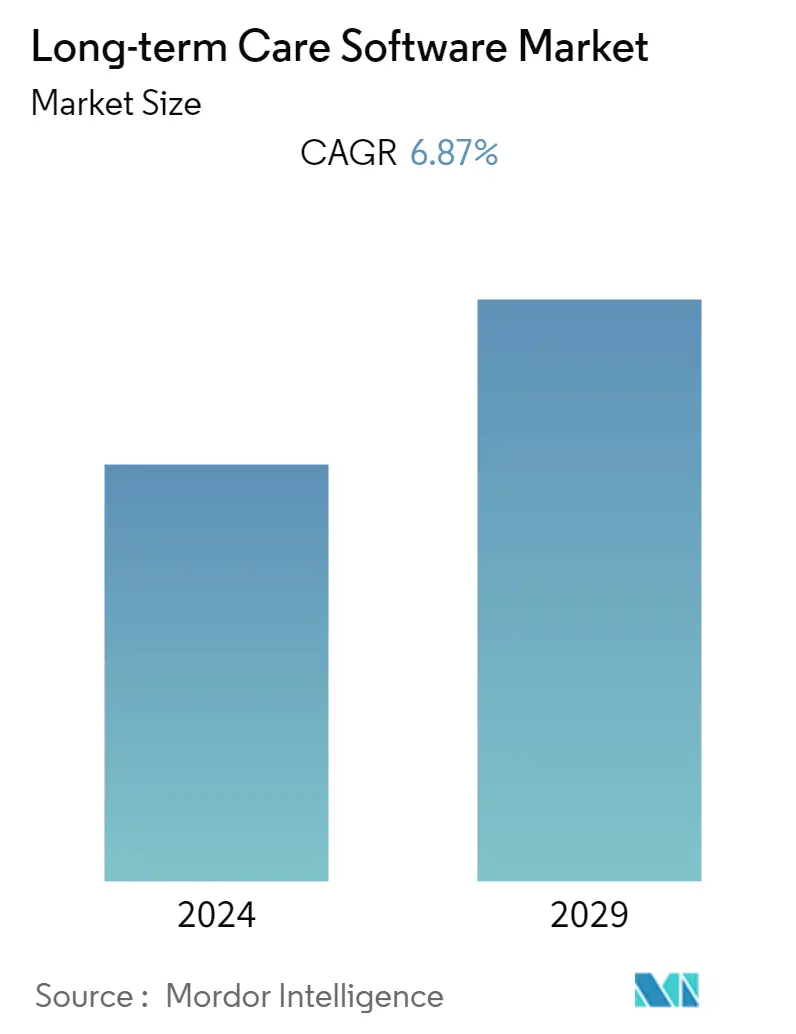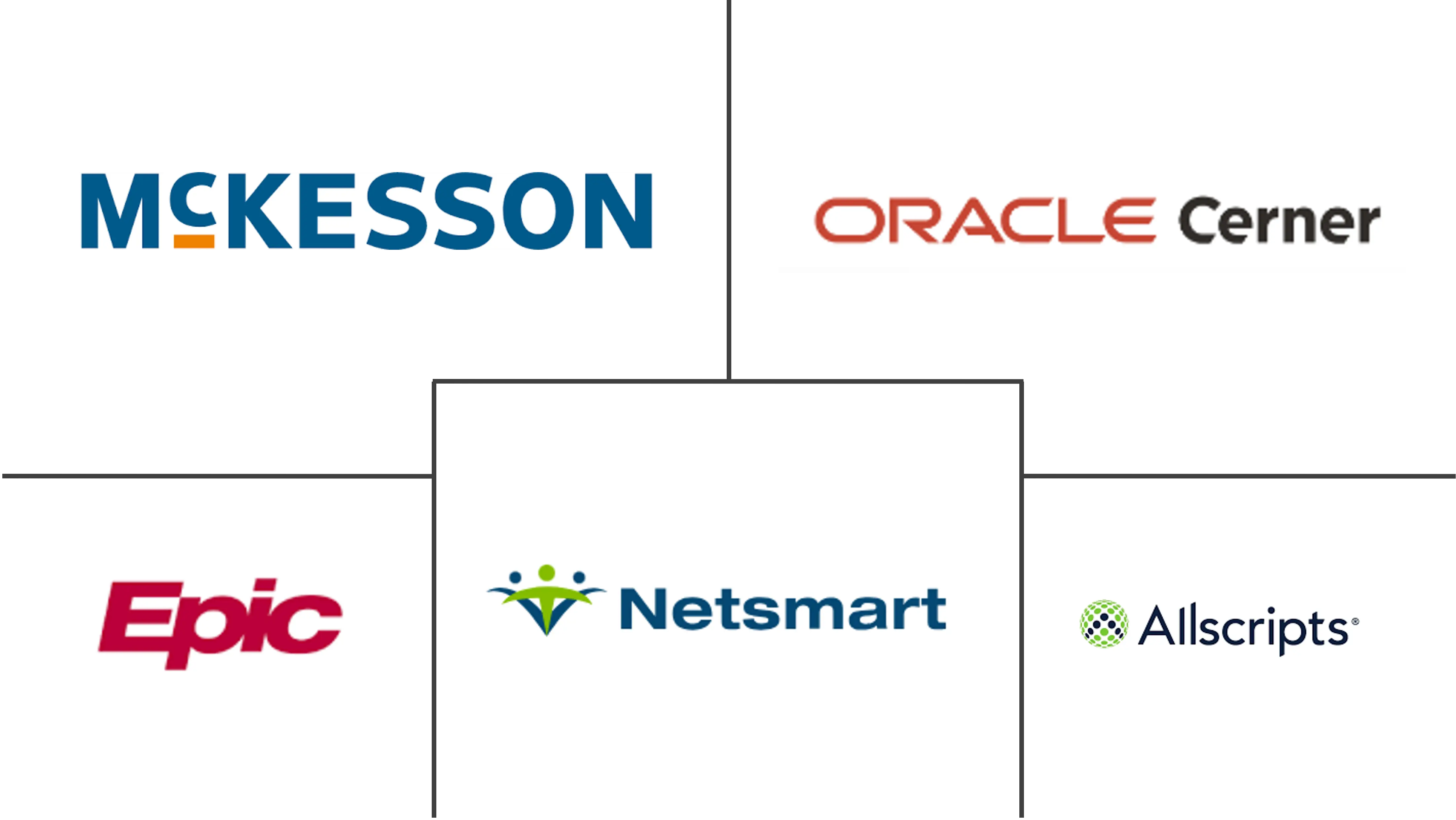Market Size of Long-term Care Software Industry

| Study Period | 2019 - 2029 |
| Base Year For Estimation | 2023 |
| CAGR | 6.87 % |
| Fastest Growing Market | Asia Pacific |
| Largest Market | North America |
| Market Concentration | Low |
Major Players
*Disclaimer: Major Players sorted in no particular order |
Long Term Care Software Market Analysis
The Global Long-term Care Software Market size is expected to grow from USD 4,978.12 million in 2023 to USD 6,939.76 million by 2028, registering a CAGR of 6.87% during the forecast period (2023-2028).
The COVID-19 pandemic affected the elderly population excessively, particularly those who were living at long-term care facilities (LTCF), with a significant impact on mortality and morbidity. As per the study article published in PLUS One in January 2022, the mortality rate among long-term care residents was higher. Thus, strenuous action is required to alleviate the impact of COVID-19 by enhancing infection prevention and control (IPC) measures within LTCF with novel and advanced LTC software and solutions to track and manage the patients at LTCF affected with COVID-19. In addition, during the later phases of the pandemic, GHD Group Pty Ltd revealed four new advanced solutions, namely, SimpleTrack, Contact Connect Wearables, Appointed, and Wastewater testing service, intended to increase the safety of residents in long-term care facilities through contact tracing, appointment bookings, and early notification of COVID-19 trends. Thus, as per the analysis, COVID-19 significantly impacted the growth of the studied market throughout the pandemic phase and is expected to continue its trend over the post-pandemic era.
The major factors attributing to the growth of the long-term care software market are healthcare reforms and government initiatives, the rise in the aging population, and the growing burden of chronic diseases. As per the WHO data updated in October 2022, the number of people over 60 years and above is expected to reach 1.4 billion by the year 2030 and is projected to reach 2.1 billion by the year 2050. As old people require long-term care, the demand for long-term care software is anticipated to grow and contribute to the market's growth during the forecast period.
Additionally, among the patients requiring long-term care, some of the most frequent chronic medical conditions include hypertension, gastroesophageal reflux disease, diabetes, atrial fibrillation, anemia, arthritis, congestive heart failure, constipation, chronic obstructive pulmonary disease, cerebrovascular disease, dementia, osteoporosis, Parkinson's disease, peripheral vascular disease, renal failure, and thyroid disorders, amongst others. According to Alzheimer's Disease International, someone develops dementia every 3 seconds. As per the above source, the number of people with dementia is expected to double every 20 years; by 2030, it is anticipated to reach 78 million, and by 2050, nearly 139 million. Therefore, to control and monitor such a large section of the old age population prone to any chronic disease at any point in time, even if the disease occurred once, it is important to get them monitored at home care, nursing facility, or community centers, as well as assisted living centers. The importance of software and devices to connect to these centers and patients becomes necessary, and thus, acts as one of the major drivers for the market studied.
Moreover, government policies and acts, such as the Health Information Technology for Economic and Clinical Health Act (HITECH), improve healthcare quality, safety, management, and efficiency, including electronic health records (EHRs) and private and secure electronic health information exchange are vital in proper disease management to alert clinicians promptly. Hence, the demand for long-term care software is increasing. This is further anticipated to fuel the market growth.
Long Term Care Software Industry Segmentation
As per the report's scope, long-term care software refers to software services that include electronic medical records, e-prescribing, medication management, patient monitoring, remote training, etc., which enhance the business operation's needs, patient experience, and outcomes. The Long-term Care Software Market is Segmented by Product (Electronic Health Records, E-prescribing, Clinical Decision Support Systems, Remote Patient Monitoring Systems, Real-time Location Systems, Billing, Invoicing, and Scheduling Software, and Other Products), Deployment (Cloud Bases and On-premise), End User (Home Healthcare Agencies, Hospice Care Facilities, and Nursing Homes and Assisted Living Facilities), and Geography (North America, Europe, Asia-Pacific, Middle-East and Africa, and South America). The report also covers the estimated market sizes and trends for 17 countries across major regions globally. The report offers the value (in USD) for the above segments.
| By Product | |
| Electronic Health Records | |
| E-prescribing | |
| Clinical Decision Support Systems | |
| Remote Patient Monitoring Systems | |
| Real-Time Location Systems | |
| Billing, Invoicing, and Scheduling Software | |
| Other Products |
| By Deployment | |
| Cloud-based | |
| On-premise Based |
| By End-User | |
| Home Healthcare Agencies | |
| Hospice Care Facilities | |
| Nursing Homes and Assisted Living Facilities |
| Geography | ||||||||
| ||||||||
| ||||||||
| ||||||||
| ||||||||
|
Long-term Care Software Market Size Summary
The long-term care software market is poised for significant growth, driven by factors such as healthcare reforms, government initiatives, and the increasing aging population. The demand for advanced software solutions in long-term care facilities has been amplified by the COVID-19 pandemic, which highlighted the need for improved infection prevention and control measures. The pandemic also accelerated the adoption of technologies like contact tracing and health monitoring solutions, which are crucial for managing the health of elderly residents. As the global population aged 60 and above continues to rise, the necessity for efficient long-term care software to manage chronic diseases and facilitate care in various settings, including home care and assisted living centers, becomes increasingly important. This trend is further supported by government policies aimed at enhancing healthcare quality and safety through the use of electronic health records and health information exchanges.
North America is expected to maintain a significant share of the long-term care software market, bolstered by favorable government policies, widespread insurance coverage, and a high adoption rate of new technologies. The region's market growth is also supported by initiatives from organizations like the National Institute on Aging and various state-level programs focused on aging and disabilities. The competitive landscape of the market is moderately concentrated, with major players like Allscripts Healthcare Solutions, Cerner Corporation, and McKesson Corporation leading the charge. However, the market is also witnessing the entry of smaller players, driven by rising patient awareness and the growing need for innovative software solutions. Recent developments, such as the launch of new electronic medical record applications and digital reporting solutions, are expected to further propel market growth during the forecast period.
Long-term Care Software Market Size - Table of Contents
-
1. MARKET DYNAMICS
-
1.1 Market Overview
-
1.2 Market Drivers
-
1.2.1 Rise in Aging Population
-
1.2.2 Healthcare Reforms and Government Initiatives
-
1.2.3 Growing Burden of Chronic Diseases
-
-
1.3 Market Restraints
-
1.3.1 Unwillingness of the Traditional Long-term Care Providers to Adopt Software
-
1.3.2 High Investment and Maintenance Costs
-
-
1.4 Porter's Five Forces Analysis
-
1.4.1 Bargaining Power of Buyers/Consumers
-
1.4.2 Bargaining Power of Suppliers
-
1.4.3 Threat of New Entrants
-
1.4.4 Threat of Substitute Products
-
1.4.5 Intensity of Competitive Rivalry
-
-
-
2. MARKET SEGMENTATION (Market Size by Value - USD)
-
2.1 By Product
-
2.1.1 Electronic Health Records
-
2.1.2 E-prescribing
-
2.1.3 Clinical Decision Support Systems
-
2.1.4 Remote Patient Monitoring Systems
-
2.1.5 Real-Time Location Systems
-
2.1.6 Billing, Invoicing, and Scheduling Software
-
2.1.7 Other Products
-
-
2.2 By Deployment
-
2.2.1 Cloud-based
-
2.2.2 On-premise Based
-
-
2.3 By End-User
-
2.3.1 Home Healthcare Agencies
-
2.3.2 Hospice Care Facilities
-
2.3.3 Nursing Homes and Assisted Living Facilities
-
-
2.4 Geography
-
2.4.1 North America
-
2.4.1.1 United States
-
2.4.1.2 Canada
-
2.4.1.3 Mexico
-
-
2.4.2 Europe
-
2.4.2.1 Germany
-
2.4.2.2 United Kingdom
-
2.4.2.3 France
-
2.4.2.4 Italy
-
2.4.2.5 Spain
-
2.4.2.6 Rest of Europe
-
-
2.4.3 Asia-Pacific
-
2.4.3.1 China
-
2.4.3.2 Japan
-
2.4.3.3 India
-
2.4.3.4 Australia
-
2.4.3.5 South Korea
-
2.4.3.6 Rest of Asia-Pacific
-
-
2.4.4 Middle East and Africa
-
2.4.4.1 GCC
-
2.4.4.2 South Africa
-
2.4.4.3 Rest of Middle East and Africa
-
-
2.4.5 South America
-
2.4.5.1 Brazil
-
2.4.5.2 Argentina
-
2.4.5.3 Rest of South America
-
-
-
Long-term Care Software Market Size FAQs
What is the current Global Long-term Care Software Market size?
The Global Long-term Care Software Market is projected to register a CAGR of 6.87% during the forecast period (2024-2029)
Who are the key players in Global Long-term Care Software Market?
McKesson Corporation, Allscripts Healthcare Solutions, Netsmart Technologies Inc., Cerner Corporation (Oracle) and Epic Systems Corporation are the major companies operating in the Global Long-term Care Software Market.

